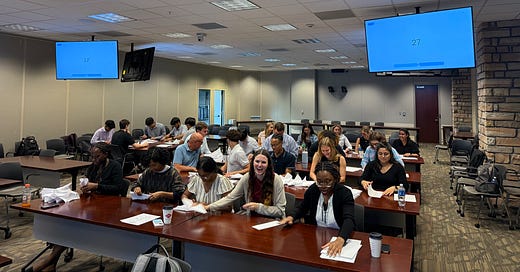MVPs, Interns, and Solving the Right Problem
While coaching at Regions Bank, I was invited to teach my Fundamentals of Managing Work class to their summer interns—a bright group eager to make an impact as future cube warriors. (Hey, I don’t hate the player—I hate the games.)
One of my favorite parts of the class is an activity that teaches how real change works. This post isn’t about the full game—just one moment that stuck with me. A moment that happened before anyone even showed up.
The Setup
I arrived an hour early. The room wasn’t flipped (industry speak for properly reconfigured). No tables. Hundreds of chairs. No help.
I had 27 interns coming and needed enough tables for the session. As I started dragging them in, I had two down and realized: this was going to take too long.
So I shifted my focus. Instead of setting up everything perfectly, I brought in just nine tables—enough to seat everyone uncomfortably, but enough to run the class. The essentials. I bought myself time and created a system I could improve later. The Agile Skateboard image immediately came to mind. I needed to make sure I had at least a skateboard, a solution that would get the job done, or risk being halfway done.
Some call that an MVP. Others call it MMF. Whatever acronym you use, the principle is this: solve the problem, not the request.
That Misunderstood Skateboard Graphic
You’ve seen the graphic. The one where someone asks for a car and gets a skateboard.
Cue the outrage:
“But I asked for a car!”
Exactly. That’s the problem.
If you ask for a car and I give you a skateboard, I’ve failed. But if you tell me you need to get to the library, and it’s down the street, maybe a skateboard works just fine.
We’ve trained ourselves to request features, not describe problems.
That’s not how real problems get solved. It’s how we get stuff. Not how we get the right thing. We get what we want, but not what we need.
Back to the Interns
My real goal wasn’t a perfectly arranged room. It was a great training session and a life changing rendition of the Airplane game.
Nine tables gave me just enough to start strong. Once things were stable, I added six more to improve comfort and flow. That’s the rhythm: deliver value early, adapt quickly.
That’s agility. That’s solving the real problem.
The faster you start solving the wrong problem, the faster you fail.
Until next time, Keep Learning, Keep Growing!





